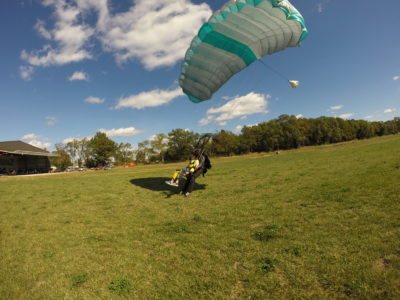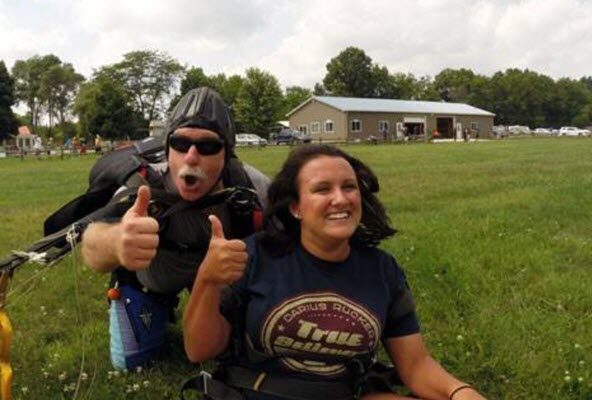- Michigan's Premier Skydiving Center
- Call Now: (517) 423-7720
Tips and Techniques to Master the Skydiving Landing
Friday, November 29, 2024
- Skydive Tecumseh
- 11/29/24
- 0
- General
At Skydive Tecumseh, we believe every part of your skydive should feel incredible, and the parachute landing is no exception! Whether you’re stepping into the world of skydiving for the first time with a tandem skydive, or looking to hone in on your skills as a licensed jumper, nailing the touchdown is both thrilling and essential.
Seeking expert advice is crucial to achieving a smooth and satisfying landing – the cherry on top of your epic skydiving adventure!
What is a Parachute Landing Called?
A parachute landing involves controlling your descent and touching down at a designated landing area. These days, most experienced skydivers either stand up or slide in when landing – thanks to the design of modern parachutes – but we all know how to execute a “PLF” or parachute landing fall.
The PLF is a military-derived parachute landing technique designed to prevent injuries. You essentially do a ninja roll once you touch the ground so that your body goes with your momentum rather than slamming to a complete stop. Skydiving students will sometimes use the PLF technique at the beginning of their training as they get used to landing the parachute.
How Are You Supposed to Land When Skydiving?
A good skydiving landing begins long before your feet touch the ground. It’s a blend of preparation, skill, and situational awareness.
Tandem Skydive Landing
For tandem jumpers, your instructor will take the lead, handling all of the technical elements of the descent, allowing you to fully take in the skydiving experience in all its glory. However, even as a tandem student, there will be important techniques you’ll need to pull off to ensure a swift landing.
 Most tandem landings involve sliding onto the ground for a soft, controlled finish. Your tandem instructor will ask you to lift your legs as the two of you slide in on your bottoms. In some cases, the instructor may stand you up for the landing. This is dependent on their discretion, so pay close attention to what your instructor says as you approach the ground, trust their judgment, and follow their cues!
Most tandem landings involve sliding onto the ground for a soft, controlled finish. Your tandem instructor will ask you to lift your legs as the two of you slide in on your bottoms. In some cases, the instructor may stand you up for the landing. This is dependent on their discretion, so pay close attention to what your instructor says as you approach the ground, trust their judgment, and follow their cues!
Solo Skydiving Landing
Licensed jumpers typically aim for a “stand up” landing, which involves flaring the parachute at just the right moment to reduce descent speed and step gently onto the ground. (More on this later.) With practice, stand-up landings become second nature.
What Are the Techniques for Skydiving Landing?
Our skydiving landing tips begin with the landing pattern. Skydiving landing patterns are crucial for successful, controlled landings. Following a standard landing pattern is important for maintaining order and safety, especially at busy dropzones. These predictable paths ensure skydivers avoid crossing flight paths, reducing the risk of collisions.
Dropzones often establish specific guidelines for altitude and turn points to standardize the landing process for all jumpers. The landing pattern is determined by the dropzone and understood by each jumper before boarding the aircraft.
Wind conditions also play a significant role in determining the landing pattern. The wind’s speed and direction can change the pattern. Ground markers – like windsocks – are essential tools for determining where and how to approach the landing area. Adapting to varying wind conditions is a skill every skydiver learns through experience and training.
Landing patterns are similar to an airplane’s approach to a runway and consist of three segments: the downwind leg, the base leg, and the final approach.
The Downwind Leg
The downwind leg involves flying parallel to the landing area with the wind behind you. You usually begin the downwind leg at around 1,000 feet. To ensure a smooth landing, you want to start slightly upwind and offset from the target, using the wind to assist your approach rather than fighting against it. Since the wind pushes from behind, the downwind leg is typically the longest, especially in windy conditions.
Properly positioning this leg is critical, as it sets the stage for the entire landing pattern. Jumpers usually follow each other in the sequence and use windsocks located down on the dropzone to determine which way the wind is blowing and which direction to start their landing pattern.
The Base Leg
At around 600 feet, you make a 90-degree turn onto the base leg – the only leg flown perpendicular to the wind. This leg can be tricky due to “crabbing,” where wind hitting from the side can push you off course. To stay aligned, you need to actively counter this sideways drift by using the toggles to steer against it.
The Final Approach
You begin the final approach around 300 feet. You make another 90-degree turn – into the wind – aligning yourself with the landing target. This is the most critical phase of the parachute landing because it must be as straight and controlled as possible to give you time to prepare your body for touchdown. The final approach requires a ton of focus and precision to ensure a successful landing.
 By mastering each leg of the landing pattern, you start to build confidence to navigate your parachute landing pattern and touchdown with ease. By practicing proper technique and staying aware of your surroundings, you can ensure smooth and controlled landings every time.
By mastering each leg of the landing pattern, you start to build confidence to navigate your parachute landing pattern and touchdown with ease. By practicing proper technique and staying aware of your surroundings, you can ensure smooth and controlled landings every time.
If you’re a beginner, don’t get discouraged if you make a small mistake, there are tons of resources and coaches at the dropzone ready to offer guidance. We all want everyone in our community to have fun and successful jumps!
Common Parachute Landing Mistakes
Even seasoned skydivers can stumble when it comes to landings. Here are a few common mistakes and how to steer clear of them:
Misjudging Wind Conditions:
Underestimating wind speed or direction can throw off your approach. Keep an eye on the windsock and adjust your landing pattern accordingly.
Poor Flare Timing:
The flare – or pulling down the parachute toggles to slow your descent – is a critical move. Flaring too early or too late can lead to a rough landing. Practice timing your flare during training jumps to build confidence.
Landing Off-Target:
Missing your mark often stems from poor planning or a lapse in altitude awareness. Pay attention to your surroundings and adjust as needed.
Turning Too Low:
According to the United States Parachute Association (USPA) and many other sources, low turns (intentional or unintentional) are the cause of most skydiving-related deaths or injuries. Low turns are when a skydiver turns their parachute while under the canopy at an unsafe altitude. You want to land with the parachute flying straight and level; making sudden, erratic toggle inputs is what can cause a dangerous landing. If you need to make a change, use your brakes to flatten out the angle of your approach while maintaining a straight and level parachute.
Advanced Parachute Landing Techniques
Once you’ve mastered the basics, have confidence, and a coach gives you the OK – you can step up your parachute landing game. While advanced landing techniques can add excitement and challenge to your skydiving journey, it is best to proceed with caution and seek advice from professional skydiving coaches and instructors. Here are some examples of advanced landings:
Accuracy Landings:
Want to hit a small target? Perfecting accuracy involves mastering your landing pattern and refining your control during the final approach.
Swooping:
For the adrenaline junkies out there, swooping is an advanced technique where skydivers descend rapidly and glide close to the ground at high speeds. It looks (and sounds) awesome but requires specialized training and skill.
Are Skydiving Landings Hard?
For tandem jumpers, your instructor is there to guide you smoothly to the ground. For solo jumpers, landing becomes second nature with practice. Like anything in skydiving, the key is to follow your training and enjoy the process rather than trying to rush onto the next level. You’ve got this!
Ready to master the art of landing like a pro? Whether you’re a first-timer or a fun jumper, Skydive Tecumseh is here to help! Book your jump today and experience the thrill of skydiving with confidence, from takeoff to touchdown. Blue skies!

Wonderful staff -- my tandem instructor, James, was funny, clear, and made sure that I was comfortable during the entire experience (which involved two flights and a bit of "will-we-or-won't-we" due to clouds).
The dive itself is unreal -- exhilarating and meditative, terrifying and relaxing, absolutely breathtaking. I absolutely recommend you try it here first. Skydive Tecumseh has a great reputation, and there's a reason for that. I hope to go again.
John Maguire
Copyright © 2025, Skydive Tecumseh, All Rights Reserved.
DropZone Web Design & Marketing by Beyond Marketing, LLC